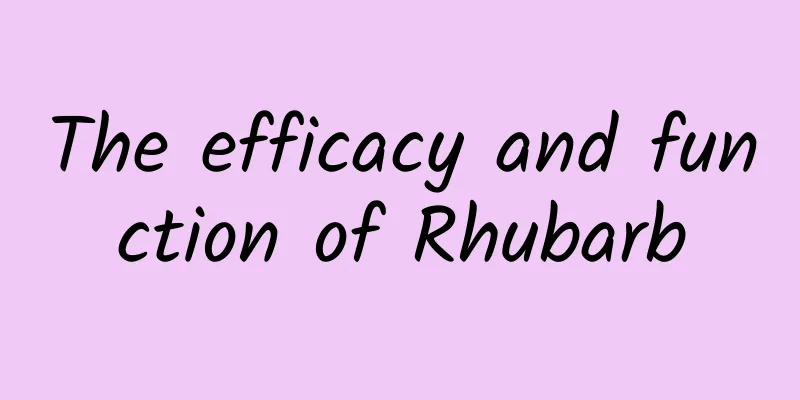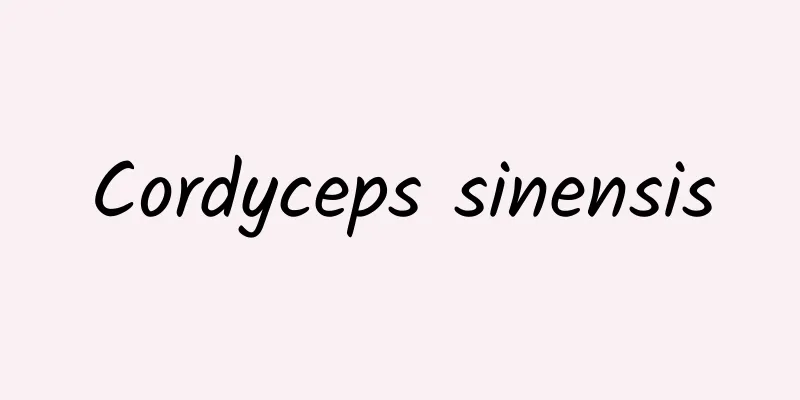The efficacy and function of Rhubarb

|
Rhubarb is a common Chinese medicine with many different functions. It can regulate some diseases of the human body. Let us learn about its specific functions below. [Other names] Tang rhubarb, Taiwan rhubarb, local rhubarb, valley yellow, seed yellow, northern rhubarb, rhubarb, Gexi Guner, wild rhubarb, sour grass, yellow ancient egg, bitter rhubarb, North China rhubarb, Qihuang, Zhuanghuang [Source] Medicinal material source: the root and rhizome of Rheum officinale of the Polygonaceae family. [Original form] Perennial herb, more than 1m tall. The rhizome is thick and the surface is yellowish brown. The stem is stout, erect, glabrous, often unbranched, and hollow. Basal leaves have long petioles; leaf blades are ovate to ovate-round, 10-16cm long, obtuse at apex, cordate at base, wavy at margins, slightly hairy beneath; stem leaves have short petioles or are sessile, stipules are oblong, dark brown, and clasping the stem. The inflorescence is borne in a panicle, with small, numerous, white-green flowers; the bracts are small and fleshy, containing 3-5 small flowers; there is a joint below the middle of the pedicel; there are 6 tepals, ovate, in 2 whorls, with the outer 3 whorls being thicker and smaller; there are 9 stamens; the ovary is triangular-ovate, with 3 styles. Achenes 3-ribbed, winged, cordate at base, with persistent perianth. Flowering period is summer. [Habitat distribution] Ecological environment: grows on hillsides, rock crevices, and grasslands. [Properties] Identification of properties: The roots and rhizomes are irregular cylindrical, thicker at the upper end and slightly thinner at the lower end, 5-10cm long and 1.5-5cm in diameter. Most of the cork has been scraped off, the surface is reddish brown and yellow, without horizontal lines, and the texture is hard and light. The cross section has no stars, but has fine and straight reddish-brown rays. The new cross section is yellow to brown-red and shows blue-purple fluorescence under ultraviolet light. It has a faint smell and tastes bitter and astringent. [Chemical composition] The root and rhizome of Rheum officinale contain 1.11% total anthracene compounds, of which 1.05% are bound anthracene compounds with emodin and chrysophanol as aglycones, and 0.06% are free anthracene compounds. It also contains edible rhapontin and a large amount of tannins [1]. 【Pharmacological action】 1. Antioxidant Effect: The water extract of this product has a strong anti-superoxide anion free radical effect, which is stronger than three kinds of genuine rhubarb and other non-genuine rhubarb. The edible rhubarb glycoside (rhubarb glycoside) it contains also has a strong antioxidant effect[1]. 【Nature and flavor】 Bitter; cold 【Meridian】 Stomach; Large Intestine 【Functions and indications】 Clears away heat and detoxifies; cools blood and removes blood stasis. It is used to treat damp-heat jaundice, dysentery, amenorrhea and abdominal pain, hematemesis, epistaxis, pain from falls and blood stasis, carbuncle, furuncle, oral erosion, burns and scalds. [Usage and Dosage] For oral use: decoct in water, 3-10g; or grind into powder. For external use: apply appropriate amount, grind into powder and sprinkle; or mix and apply on affected area. [Note] "Medicinal Plants in Desert Areas of China": Do not use if you are weak or before or after pregnancy. 【Discussions by various scholars】. 1. "Handbook of Commonly Used Chinese Herbal Medicines in Northeast China": It can relieve excess heat, break up stagnation, and promote the circulation of blood stasis. Treat jaundice, constipation, amenorrhea, carbuncles, furuncles, burns and scalds. 2. "Inner Mongolia Chinese Herbal Medicine": It can relieve excess heat, promote bowel movements, break up stagnation, and promote the flow of blood stasis. (When used raw, it has a strong inducing effect; when fried, it has a slow inducing effect; when fried into charcoal, it can stop bleeding). It is used to treat heat-stagnation, mumps, internal and external carbuncles, bruises, burns, blood stasis, swelling and pain, hematemesis, and epistaxis. 【Excerpt】 Chinese Materia Medica Now you know the function of rhubarb. I didn’t know that rhubarb is such a valuable thing before, which shows that our knowledge is not broad enough. So in the future life, learning more about it can be a good way to maintain health. In fact, if you want to maintain health, there is knowledge everywhere in life. |
<<: The efficacy and function of Shan Dayan [picture]
>>: The efficacy and function of turtle head
Recommend
The fairy by the water, whose light dance brings spring all year round, what an elegant bird is she?
A bird's eye view of science Quanzhou Associa...
The role and efficacy of red peony root
Medicine is a very common thing in life. It is ve...
These 13 pieces of knowledge in the circle of friends that look like rumors at first glance are actually true!
Source: Dr. Curious (ID: haoqi238)...
What can't be eaten with Codonopsis?
In life, many people have experienced weak qi and...
The medicinal value of the bird-free tree
The bird-free tree is a shrub, and because it has...
"Teacher, I really didn't perm my hair!" - A desperate cry from a natural curly girl
——Why are some people naturally curly and some no...
The efficacy and function of Huangpi Xueteng
There are many common Chinese medicinal materials...
The hairy crab waits two years for its once-in-a-lifetime mating opportunity, and then…
Maple leaves turn red, osmanthus fragrance wafts ...
Beef belly hotpot, monkey dung olives... the behavioral patterns of species are more colorful than we think
Calendar Girl Asks Which of the following is a hu...
Chinese medicine Melia azedarach
Melia azedarach is a kind of fruit that many frie...
The efficacy and function of maple parasite
The medicinal value of maple parasite is beyond o...
How did mammals rise? These animals living in China 125 million years ago were the key
From whales that live like fish in the ocean, to ...
It is called "Ichthyosaur", but it is neither a "fish" nor a "dragon". It was once the "overlord" of the Triassic Ocean!
The most serious mass extinction event in geologi...
The effect of Houttuynia cordata
Houttuynia cordata (also known as Houttuynia cord...
What is Broken Wall Pine Pollen?
Everyone knows the nutritional components and eff...









